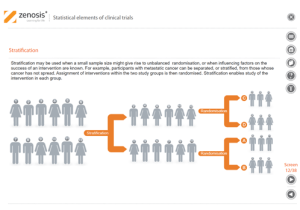Statistical elements of clinical trials
Course Summary
Analytical statistical elements are essential concepts in the design of clinical trials. This analysis helps us to understand whether a conclusion from a study of a sample of the target population applies generally to that population as a whole. In particular, it helps us to answer the question: Did the treatment effect in the given study occur just by chance? The statistical elements of a well-controlled study minimise the chances of drawing the wrong conclusions, by providing clear thresholds for such errors. The basic statistical elements of a clinical trial include eligibility criteria, randomisation, sample size, power, and blinding, and these are discussed in this short course.

Purchasing Information
When you have completed your course order, Zenosis will finalise the setup of your course materials and contact you on the email address that you provide in your order. You can expect this process to be completed within one business day (using the UK business calendar) of completing your payment.
It is therefore essential that you use your real email address for your order, or indicate in the purchase notes the email address to be used for the course set-up, and check that any messages from Zenosis or grapl are not lost in your junk or spam folder.
You will have access to the course module(s) for a period of 180 days after your purchase is complete.
Detailed Course Information
• Identify the basic statistical elements of clinical trial design
• Define eligibility criteria as detailed in the ICH guideline for Good Clinical Practice
• Describe the concepts of randomisation and stratification
• Outline the information required to calculate sample size
• Explain the importance of blinding
This module is intended for all those involved in the preparation, design, conduct or analysis of clinical trials. It will be useful to new entrants to the field or as a refresher for staff, including clinical research associates and data managers, in the clinical/medical departments of pharmaceutical or biotechnology companies or in contract research organisations. It will also be of interest to clinical investigators, study coordinators, and other healthcare staff working on clinical trials.
